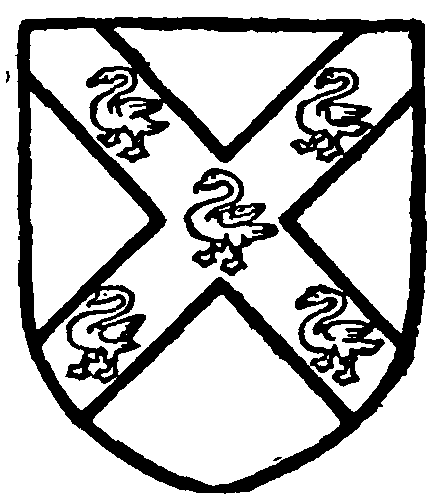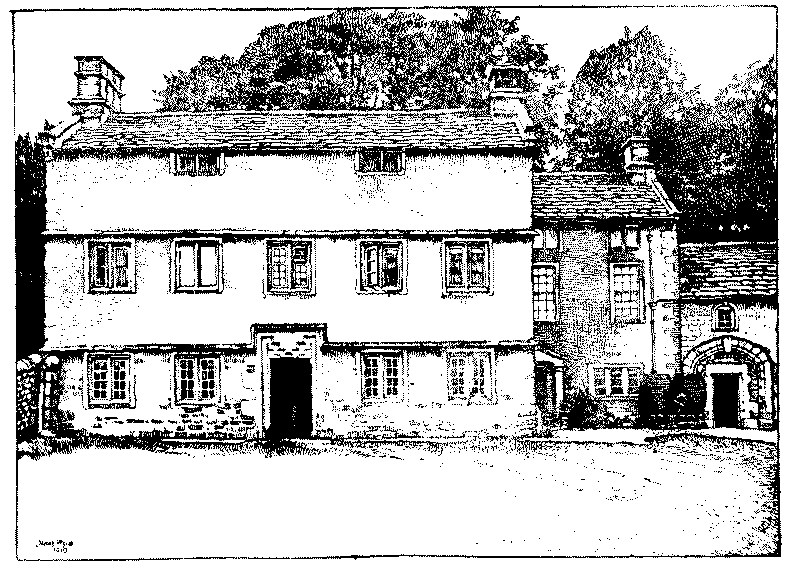Pages 85-89
A History of the County of Lancaster: Volume 8. Originally published by Victoria County History, London, 1914.
This free content was digitised by double rekeying. All rights reserved.
In this section
GRESSINGHAM
Ghersinctune, Dom. Bk.; Gersingeham, 1183; Gersingham, 1203; Gressingham, 1205; Kersingeham, 1260.
This detached township stands on the north-west side of the Lune, into which flows a small stream, rising at the western edge of the township and flowing east through the village. North and south of this stream the land rises in little hills, heights of 300 and 400 ft. above sea level being attained. The hilly land to the south of the village is called Eskrigg; southwest of it, across a wooded clough, are Higher and Lower Snab. The acreage is 2,014½, (fn. 1) and in 1901 there was a population of 119.
From the village a road goes east to Hornby, crossing the Lune by a bridge; west it goes to join the road from Lancaster to Kirkby Lonsdale, and has a branch to Aughton on the south-west. Another road goes north from the village to the Kirkby Lonsdale road and south to Eskrigg.
The land is mostly used for grazing.
Two natives of the place obtained distinction in the 16th century. Edmund Scambler, born about 1520, was educated at Cambridge, (fn. 2) and became a Protestant, ministering secretly in London during the Marian persecution. (fn. 3) On the accession of Elizabeth he was made Bishop of Peterborough in 1561. (fn. 4) In 1584 he obtained promotion to Norwich, where he among other acts in 1588–9 condemned and burnt one Francis Kett. He died in 1594, leaving a large family and a large fortune. He was esteemed a good preacher, and was one of the translators of the Bishops' Bible. (fn. 5)
Thomas Penny, son of John Penny, was likewise educated at Cambridge, and became a Protestant. He was made prebendary of St. Paul's, but was deprived for nonconformity in 1577. He was famous as a botanist. (fn. 6)
Manor
Earl Tostig held GRESSINGHAM in 1066 as a dependency of Whittingham; it was then assessed as two plough-lands, (fn. 7) but later as one plough-land only. Some time after the Conquest it was granted to foresters—three-fourths (6 oxgangs) to one whose duty it was to keep the king's goshawks nesting in Lonsdale until they were strong, when he was to deliver them to the sheriff, the other fourth (2 oxgangs) to another forester, (fn. 8) who kept the aeries of the king's hawks. The services in later times were commuted for a rent of 3s. 6d. There was also the service called cowmale, which was commuted for 2s. 6d. (fn. 9)
The manor was thus divided from an early period, and became so much further divided by grants and by partition among co-heirs, each portion apparently being regarded as a 'manor,' that it becomes impossible to trace the descents. The earliest possessor known of the 6 oxgangs of land was Bernard, who granted 2 oxgangs to a son Bernard, who was in return to discharge the service due to the king. (fn. 10) The eldest son, Geoffrey de Gressingham, was living 1193 to 1204, (fn. 11) and left a daughter and heir Alice; he had given half an oxgang of land to his brother Adam and a little land also to Lancaster Priory. (fn. 12) Alice, the heir, was married to Thomas son of Adam de Kellet, (fn. 13) who was in possession in 1212. (fn. 14) Their daughter Christiana probably married a Burgh, for about 1270 William de Burgh (Burrow) was lord of Gressingham. (fn. 15) It appears that in 1228 the Icing granted Over Wyresdale and the land of Gressingham to the great Hubert de Burgh and his wife. (fn. 16) The coincidence of surnames is curious, as there was no connexion between the families. William de Burgh had a son and heir Adam, (fn. 17) after whom the family disappears, but the Harringtons afterwards occur among the principal tenants. (fn. 18) Their estate (fn. 19) descended probably to Lord Mounteagle, who had a grant of the manor from the Crown, (fn. 20) and the owner of Hornby is still regarded as lord of the manor of Gressingham. (fn. 21)

Burgh of Gressingham. Argent on a saltire sable Jive swans of the field.
The earliest possessor of the 2 oxgangs of land seems to have been the Kettel de Gressingham who in 1203–4 contributed half a mark to the scutage. (fn. 22) In 1212 this portion was held by William son of Dolfin and William son of Gilbert, (fn. 23) and about ten years later by William and Benedict. (fn. 24) The latter is probably the Benedict son of Kettel whose right to I oxgang of land was acknowledged by Adam de Coupmanwra in 1235. (fn. 25) From this time the descent becomes obscured, (fn. 26) but in 1346 the holders of this oxgang were John de Twisleton, Lawrence Balrig and Cecily de Southworth. (fn. 27) Two of these families were of long continuance in the township; the Twisletons had Over Hall till the middle of the 16th century, (fn. 28) and the Southworths, who continued till about 1500, (fn. 29) perhaps had Nether Hall, which was later the property of a family named Thompson. (fn. 30) Both were afterwards held by Croft (fn. 31) and West. (fn. 32)
The only other noteworthy family was that of Green, whose estate was called a manor (fn. 33); it descended in the 16th century to Parker. Some other names occur, as Lancaster, (fn. 34) Washington, (fn. 35) Middleton (fn. 36) and Redmayne. (fn. 37) Eskrigggave a surname to residents. (fn. 38)

Gressingham Hall
Cockersand Abbey (fn. 39) and Lancaster Church (fn. 40) had lands in the township.
The freeholders recorded in 1600 were William Parker, John Thompson and Richard Johnson, the last being of Eskrigg. (fn. 41) Francis Wood, as a Royalist 'delinquent in both wars,' compounded with the Parliamentary authorities for his estate; his fine was £51 15s. (fn. 42)
Church
The church of ST. JOHN THE EVANGELIST (fn. 43) stands on high ground sloping to the south and consists of a clearstoried chancel and nave of three bays under one roof with north aisle of equal length and west tower. The building was 'restored,' or perhaps rebuilt, in 1734, (fn. 44) and was further altered in 1862, to which date all the windows, which are of Gothic design, belong. The latter alterations were carried out under the superintendence of Messrs. Austin & Paley.
The walls are of rubble and the roofs are covered with stone slates and have overhanging eaves. The tower has a plain parapet with flat coping and single-light belfry windows. On the south side there is a good 12th-century roundheaded doorway, 3 ft. 3 in. wide, of three moulded orders springing from imposts and moulded jambs 6 ft. high, the height of the doorway being 7 ft. 9 in. The middle order has the cable mould and the outer one the cheveron, and there is a modern hood mould. (fn. 45) The font, which stands under the tower, is plain and may be ancient. The pulpit is dated 1714 and bears the initials of the Rev. Richard Thompson, curate. There is a brass inscribed 'Near this Pillar lieth the Body of old Robert Eskrigge of Eskrigge and Richard his son and Robert his grandson Robert Eskrigge of Winnick Clerk fixed me here and Richard and Robert their heires now appeare 1696. Non imagine loquamur sed vivunt.' In the vestry are an old oak chest and two old chairs. There is one bell by Luke Ashton of Wigan inscribed 'Gloria in excelsis Deo. Thomas Williamson warden 1740.' The registers begin in 1710.
Advowson
The chapel of Gressingham, which originally belonged to Melling, (fn. 46) was given by Roger de Montbegon, lord of Hornby, who died in 1225–6, to the abbey of St. Martin at Sees, (fn. 47) and so became dependent upon Lancaster Church. A graveyard was consecrated in 1230. (fn. 48) By the ordination of the vicarage in 1430 Gressingham was to have a resident curate, and the obligation was probably fulfilled. (fn. 49) The religious changes of the 16th century did not relieve the vicar of Lancaster from this duty and in 1610 there was a curate in charge. (fn. 50) The minister in 1650 desired his chapelry to be made into a parish, with the additions of Aughton from Halton and Arkholme from Melling. The income at that time was £6 13s. 4d. from small tithes, with £40 added from the sequestered estate of Lord Morley, 'a Papist delinquent.' (fn. 51) This addition would cease at the Restoration, and in 1717 the income was under £9, partly from small tithes and partly from the rent of a parcel of land. The curate then read prayers and preached every Sunday. (fn. 52) After the restoration or rebuilding of the chapel (fn. 53) in 1734 a further endowment of £800 was procured from Queen Anne's Bounty. (fn. 54) The net value is stated as £84 a year.
The incumbents, styled vicars, are presented by the vicar of Lancaster. The following is an imperfect list:—
| oc. 1674 | Anthony Lund (fn. 55) |
| oc. 1677 | Thomas Garforth, B.A. (fn. 56) (St. John's Coll., Camb.) |
| 1684 | Richard Thompson (fn. 57) |
| 1725 | Alexander Bagot, B.A. (fn. 58) (Christ's Coll., Camb.) |
| 1758 | Robert Armitstead (fn. 59) |
| 1807 | John Atkinson, M.A. (fn. 60) |
| 1808 | Richard Davies, B.A. (fn. 61) |
| 1820 | William Nelson (fn. 62) |
| 1838 | William Stratton, B.A. (St. Edmund Hall, Oxf.) |
| 1857 | William Stratton, B.A. (New Coll., Oxf.) |
| 1890 | William Suffield Forster Maynard, B.A. (T.C.D.) |
| 1898 | Thomas Mercer, B.A. (Corpus Christi Coll., Camb.) |


